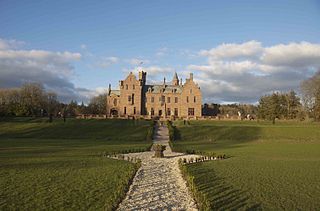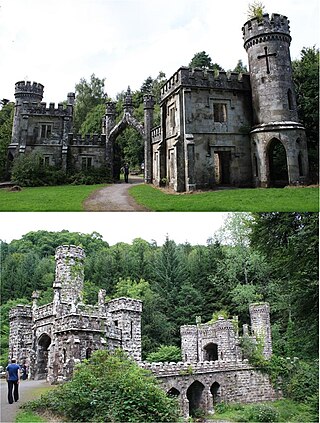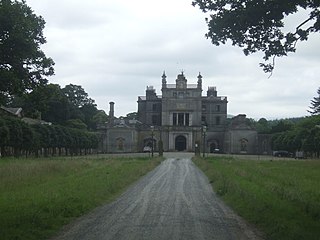
Strancally Castle is a country house in County Waterford, Ireland. It is located on the River Blackwater, close to the town of Youghal in County Cork.

Strancally Castle is a country house in County Waterford, Ireland. It is located on the River Blackwater, close to the town of Youghal in County Cork.
The original Strancally castle was built by Raymond le Gros. It was then reputedly occupied by Spaniards, who lured the local landowners to a banquet and then dropped them through a secret trapdoor into a flooded cave. When news of the murder hole leaked out the Spanish were routed and the castle destroyed.
The present building was designed and built around 1830 by James and George Richard Pain for John Keily, MP for Clonmel, and the High Sheriff of County Waterford for 1819–20. It stands in front of the ruin of the original Desmond castle.
In 1856 the castle, in an estate of 5000 acres, was bought by 24-year-old George Whitelocke Lloyd of a wealthy Anglo-Irish manufacturing family. He was appointed High Sheriff of Waterford for 1859–60. [1] His son William Whitelocke Lloyd was an army officer who fought in the Anglo-Zulu War of 1879 and was an accomplished artist. [2]
The estate eventually came into the possession of the Irish Land Commission, who sold off the land piecemeal before selling the house with a remaining 160 acres. [3]

County Waterford is a county in Ireland. It is in the province of Munster and is part of the Southern Region. It is named after the city of Waterford. Waterford City and County Council is the local authority for the county. The population of the county at large, including the city, was 127,363 according to the 2022 census. The county is based on the historic Gaelic territory of the Déise. There is an Irish-speaking area, Gaeltacht na nDéise, in the southwest of the county.

Mitchelstown Castle, the former home of the Anglo Irish Earls of Kingston, was located in the north County Cork town of Mitchelstown in Ireland.
Eyrecourt Castle was an Irish 17th century country house in Galway which became a ruin in the 20th century. The house, the surrounding estate, and the nearby small town of Eyrecourt all took their name from Colonel the Right Hon. John Eyre, an Englishman who was granted a large parcel of land in recognition of his part in the military campaign in Galway during the Cromwellian conquest of Ireland. There was an earlier fortified house or castle on the same land.

Inistioge is a small village in County Kilkenny, Ireland. Historically, its name has been spelt as Ennistioge, Ennisteage, and in other ways. The village is situated on the River Nore, 25 kilometres (16 mi) southeast of Kilkenny. Inistioge is in a townland and civil parish of the same name.

Glenveagh Castle is a large castellated mansion located in Glenveagh National Park, County Donegal, Ireland and was built in about 1870.

Bailieborough Castle was located in Bailieborough, County Cavan, Ireland. It was built in an enclosed demesne by 1629. Also known as Castle House, Lisgar House, or simply 'The Castle', the country house was located just to the south-west of Castle Lough in what is now known as Bailieborough Demesne, on the north-western edge of the town. It was largely destroyed by fire in the early 20th century and is now totally demolished.

Castle Oliver is a Victorian castle-style country house in the southern part of County Limerick, Ireland. Built for entertaining rather than for defense, it has a ballroom, drawing room, library, morning room, dining room and hall which feature hand-painted ceilings, decorated ornamental corbels, superbly executed stained glass windows and stencil work. The castle stands on massive terraces and has a commanding view over much of its former 20,000-acre (81 km2) estate. The castle has Ireland's largest wine cellar, said to hold approximately 55,000 bottles.

Welcombe Hotel occupies a 19th-century former country mansion house near Stratford upon Avon, Warwickshire, which was previously known as Welcombe House. It is a Grade II* listed building.

Apley Hall is an English Gothic Revival house located in the parish of Stockton near Bridgnorth, Shropshire. The building was completed in 1811 with adjoining property of 180 acres (0.73 km2) of private parkland beside the River Severn. It was once home to the Whitmore & Foster families. The Hall is a Grade II* listed building claimed as one of the largest in the county of Shropshire.

Temple House is a Georgian mansion set in an estate of over 1,000 acres (400 ha). It overlooks the lakeside ruins of a castle formerly of the Knights Templar, and is now a country guest house. Originally built c. 1825, it was substantially extended and embellished c. 1864.
The High Sheriff of County Waterford was the Sovereign's judicial representative in County Waterford. Initially, an office for a lifetime, assigned by the Sovereign, the High Sheriff became an annual appointment following the Provisions of Oxford in 1258. Besides his judicial importance, the sheriff had ceremonial and administrative functions and executed High Court Writs.

Mount Congreve is a 17th-century Georgian estate and mansion situated near the village of Kilmeaden in County Waterford, Ireland. The architect was John Roberts, a Waterford-based architect who subsequently designed and built most of the 18th-century public buildings in Waterford, including both cathedrals. The House is situated close to the Southern bank of the River Suir approximately 7 kilometres from Waterford City. It overlooks County Kilkenny to the North.

Ballysaggartmore Towers are two ornate entrance lodges that are situated on the former Ballysaggartmore Demesne approx 2.5 kilometres from the town of Lismore in County Waterford, Ireland. The structures are considered architectural "follies".

Ennistymon House, sometimes known as Ennistimon House, is a former country house in the village of Ennistymon, County Clare in Ireland. Built on the elevated site of a medieval castle, the 18th century house is now in use as a hotel. The hotel, the Falls Hotel, is owned by members of the McCarthy family.

Humewood Castle is a 32,668 square feet (3,035.0 m2) Gothic-fantasy mansion built in 1870 in 427 acres of parkland at Kiltegan, County Wicklow in Ireland. The mansion was originally built as a private residence of the Hume family. As of 2024, it is owned by American billionaire John C. Malone.

Kilronan Castle, previously known as Castle Tenison, is a large country house standing in 40 acres (16 ha) of parkland on the shore of Lough Meelagh in County Roscommon, Republic of Ireland, 2 kilometres (1.2 mi) from the village of Ballyfarnon.

Hazelwood House is an 18th-century Palladian style country house in the parish of Calry, in County Sligo in north-west Ireland. The house, which is located in a 70-acre (28 ha) demesne approximately 2 miles (3 km) south-east of Sligo town, is a protected structure. Hazelwood, an ancient area of woodland, forms part of the original estate.

Curraghmore near Portlaw, County Waterford, Ireland, is a historic house and estate and the seat of the Marquess of Waterford. The estate was part of the grant of land made to Sir Roger le Puher by Henry II in 1177 after the Anglo-Norman invasion of Ireland. Since then, the De La Poer Beresford family has owned these estates. It is the oldest family home in Ireland.

Cappoquin House also known as Belmont is an 18th-century classical-style mansion overlooking the town of Cappoquin in County Waterford, Ireland. The house is the seat of the Keane Baronets of Belmont and of Cappoquin.

Gurteen de la Poer, or Gurteen le Poer, is an Elizabethan Revival house in County Waterford, Ireland, situated on the south bank of the River Suir, close to Kilsheelan and about 8 km east of Clonmel.